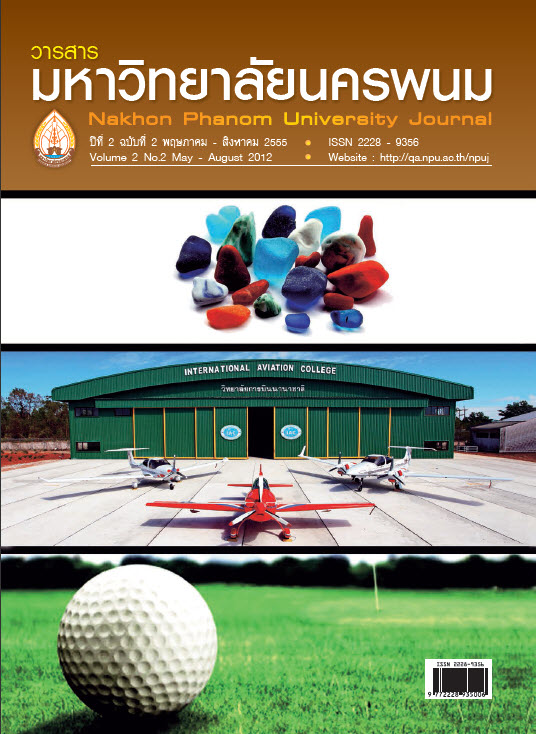ประสิทธิภาพการตรวจซ่อมบำรุงเครื่องบินในระดับการซ่อมใหญ่โดยระบบ เอส เอ พี
Main Article Content
Abstract
การวิจัยนี้ มีวัตถุประสงค์ เพื่อศึกษาปัญหาและอุปสรรค และประสิทธิภาพการซ่อมบำรุงเครื่องบินในระดับการซ่อมใหญ่ โดยระบบ เอส เอ พี ของฝ่ายช่างดอนเมือง บริษัทการบินไทย จำกัด (มหาชน) กลุ่มตัวอย่างในการศึกษาคือกลุ่มบุคคลที่ทำงานในระดับ การซ่อมใหญ่ของฝ่ายช่างดอนเมือง โดยกำหนดกลุ่มเป้าหมายแบบเจาะจงเฉพาะผู้ที่มีประสบการณ์ตั้งแต่ 10 ปีขึ้นไป ด้วยการสัมภาษณ์รวมจำนวน 11 คน และผู้เกี่ยวข้องเพื่อตอบแบบสอบถามอีก 9 คน รวมทั้งสิ้น 20 คน เครื่องมือในการเก็บรวบรวมข้อมูล ในครั้งนี้ได้แก่ แบบสัมภาษณ์แบบมีโครงสร้าง แบบสอบถาม และการสังเกต โดยดำเนินการศึกษาวิจัยด้วยระเบียบวิธีวิจัยเชิงสถิติ พรรณนา ผลการวิจัยพบว่า ปัญหา ได้แก่ การบริหารบุคคลยังขาดประสิทธิภาพ ไม่สามารถปรับกำลังคนที่มีให้เหมาะสมกับปริมาณงานในแต่ละโรงซ่อมบำรุงได้ และการจัดการ อะไหล่ ชิ้นส่วน อุปกรณ์ ที่มีขั้นตอนซับซ้อนใช้เวลาในการจัดหามาก สำหรับระบบ เอส เอ พี นั้นเป็นเพียงเครื่องมือในการประมวลผลข้อมูล จึงไม่มีผลต่อการปฏิบัติงานของพนักงานช่าง ส่วนอุปสรรค คือ งบประมาณ เพื่อการปรับปรุงโรงซ่อม และข้อจำกัดด้านวิศวกรรม เกี่ยวกับการแก้ไขซ่อมแซมความเสียหายหรือข้อขัดข้อง ในขณะที่ประสิทธิภาพที่ ขึ้นกับปัญหาคือ การบริหารบุคคล ให้เพียงพอและเหมาะสมกับปริมาณงาน การจัดการ อะไหล่ ชิ้นส่วน อุปกรณ์ ให้มีประสิทธิภาพพิ่มขึ้น สำหรับประสิทธิภาพที่ขึ้นกับอุปสรรคคือ การจัดทำแผนด้านงบประมาณไว้ล่วงหน้า และจัดลำดับความสำคัญของงานให้เหมาะสมกับเวลาและลักษณะของงาน การไม่สามารถแก้ไขปัญหาหรืออุปสรรคอย่างใดอย่างหนึ่ง ทำให้เกิดการขอขยายเวลาการตรวจซ่อมบำรุง หรือขอลดปริมาณงานให้น้อยลง เป็นการทำให้สัดส่วนของการปฏิบัติงานต่อระยะเวลานั้นผิดไปจากที่กำหนดไว้แต่เดิมข้อเสนอแนะจากการวิจัยคือ ควรพัฒนาการบริหารและการจัดการปัญหาและอุปสรรคให้มีประสิทธิภาพเพิ่มขึ้น เพื่อรักษาประสิทธิภาพการซ่อมบำรุงเครื่องบินในระดับการซ่อมใหญ่ โดยระบบ เอส เอ พี
The purpose of this research was to study the problems, obstacles, and efficiency of aircraft overhaulmaintenance by using the SAP system of the Technical Department (Don Mueang), Thai Airways International Public Co., Ltd. The sample groups used in the study were 11 staff who were in charge of the aircraft overhaul maintenance of the Technical Department gained by using purposive sampling to select only the staff who had more than 10 years of experience for interviews and 9 related staff who were asked to give responses to the questionnaire totaling 20 subjects. The instruments used to collect data were structured interviews, a set of questionnaires, and observations. Descriptive statistics were used for data analysis. The results of this research were as follows: The problems found in this study were that the personnel administration lacked efficiency. They could not put the right number of the available manpower in the hangars to suit the volume of work of each hangar. Moreover, there was a lot of red tape involved in the management of spare parts and equipment causing the time-consuming procurement. For the SAP system, it was just a tool for data processing, so it did not have an effect on the operation of the mechanics. The obstacles were the budget for improving the hangars and the engineering constraint on the repair of the damage or the malfunctions. The efficiency based on the problems included the personnel administration by staffing in proportion to the amount of work and improving the spare parts and equipment management efficiently. The efficiency based on the obstacles included preparing budget plans in advance and prioritizing work to suit the time and types of work. Not being able to solve either the problems or the obstacles would lead to the request for the extension of time required for the maintenance orthe reduction of the amount of work. However, this may make the proportion of work to time deviate from the original schedule. Recommendations from the research were that they should improve the administration and management of the problems and obstacles to maintain the efficiency of the aircraft overhaul maintenance by using the SAP system.


